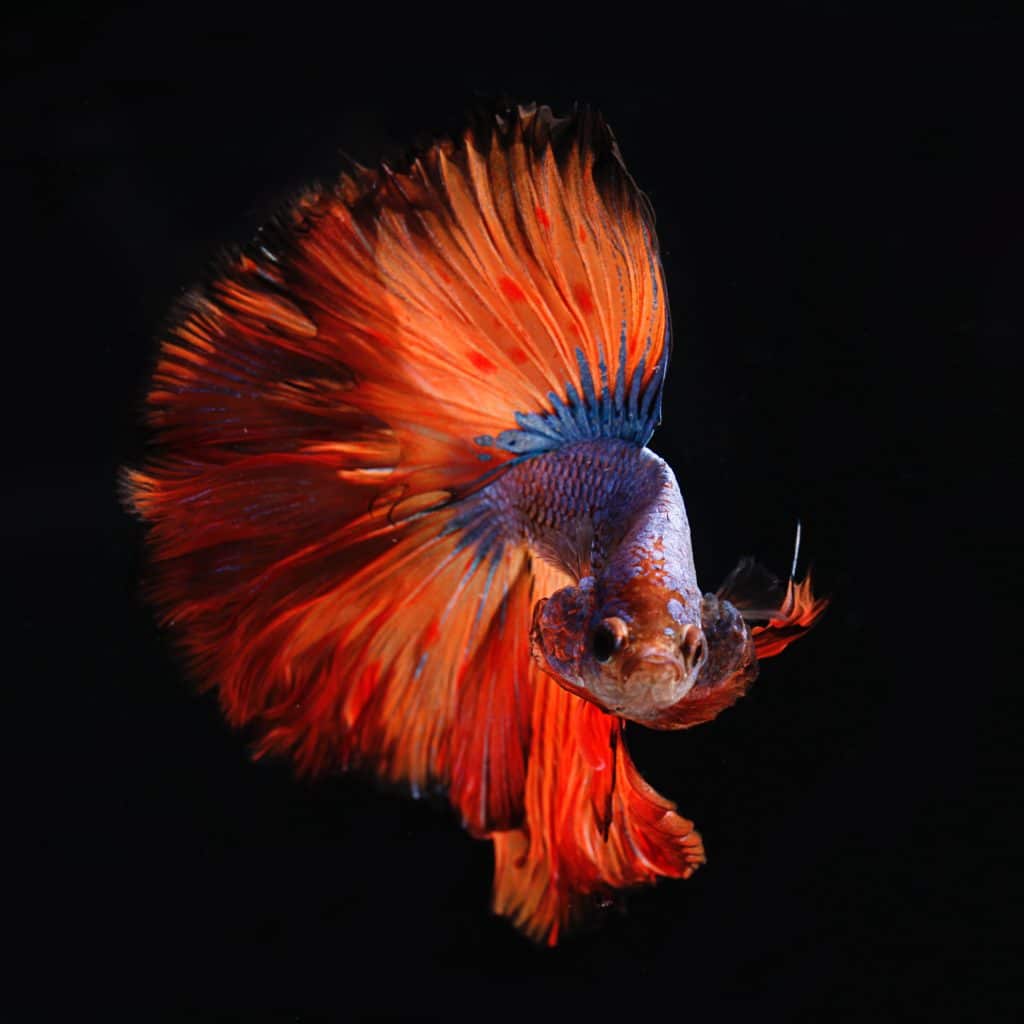Do Betta fish see colours?
Bettas have the ability to see and distinguish different colours such as red, blue, and green. Their ‘monocular vision’ allows them to perceive and see objects in two different directions at the same time. However, they do not have the ability to perceive colours in depth.
This article provides a detail explanation about the vision of Betta fish and their ability to see colours.
Yes, Bettas can see colours
The eye of the Betta fish turns on the axis on which the lower rectus muscle is located. The optic nerve enters the eyeball at about the same place near the axis of rotation, which allows it to avoid excessive twisting. The oblique muscles turn the eye forward and down, the lower and inner straight lines return it to the dorsal position.
Bettas can perceive different colours within the visible spectrum, which are determined by the wavelengths of the light. The shorter wavelengths are violet, blue, and green whereas the longer wavelengths are orange and red. Their iris does not work fast, which makes them incapable of adjusting quickly to changes in brightness. The vision of Betta fish is relatively poor. Therefore, they use ‘lateral lines’ that run down their sides to help improve their vision. In addition, the lateral line consists of smaller holes, which allows them to sense different objects and colours. In general, they lack keen eyesight.
For most animals, the world is available in black and white. Some of them are able to distinguish only certain colour shades. For example, dogs can clearly see the yellow and blue colour tones. Scientists have shown that fish can see the same colour spectrum as human beings. However, it all depends on the living conditions, the transparency of the water, and the intensity of light.
The Betta fish retina abounds in light-sensitive receptors. The retina of the human eye has three types of cones, which are able to perceive the three primary colours such as red, green, and blue. All aesthetic shades are obtained by superimposing one colour on another. In total, a human being is able to distinguish about 300 colour shades. Bettas have significantly more cones, which mean that in the daytime, they are able to perceive a wider range of colours. This may even include ultraviolet light.

General perception of colour
The perception of colour is determined by its spectral composition, brightness, and contrast with surrounding light sources and non-luminous objects. The wavelength range from 0 nm to 380 nm is considered to be invisible and is called the ultraviolet region of optical radiation. The wavelength range from 780 nm to 1 mm is also considered to be invisible and called the infrared region of optical radiation. The colour of the object perceived by the organs of vision will correspond to the wavelengths reflected by these objects. For example, the foliage seems green due to the fact that the leaf reflects the green component of the spectrum, and on the contrary, absorbs all other components.
Most species of fish can distinguish all the colours that a person sees. Of course, between different types of fish, there is a huge difference in the possibilities of distinguishing colours. It also depends on the natural conditions of the habitat (water transparency and light intensity). The eye of the Betta fish is arranged similarly to the eye of other vertebrates. The main role in the process of vision is the retina. There are two types of photoreceptor cells – rods and cones. The rods receive perceive low-intensity light and cones operate in strong light. Cones are responsible for the distinction of colours in Bettas.
Betta fish vision is mediated by four visual pigments that absorb light with different wavelengths. Each pigment consists of a chromophore and a transmembrane protein called opsin. Mutation of opsin in SWS-1 pigment allows to absorb UV radiation (360 nm), i.e. Betta can see objects reflecting ultraviolet light. They have developed and retained this ability. UV sensitivity may be associated with feeding, communication, and choice of sexual partner.
It is difficult to determine whether Bettas are sensitive to polarized light, although some other species hint at this. This ability has been identified in anchovies, which are not aquarium fish. Susceptibility to polarized light can provide better contrast and/or directional information for migratory species. Polarized light prevails at dawn and dusk. Polarized light reflected from these fish species’ scales can help other fish to distinguish an individual against a blurred background. This information is especially useful for schooling fish when oriented relative to each other. Most fish species have double cones, a pair of conical cells connected to each other. Each double cone cell can have a different absorption peak, and behavioral experiments indicate that each type of cone-shaped cell provides separate information. Thus, the signal from the individual cells in the cone composition is not necessarily summed.
What do Bettas see?
Most research studies on the vision of Bettas are done either by chemical or physical examination of the different eye parts or by determining how Bettas respond to various stimuli or images. Scientists say that it is not easy to make broad generalizations concerning the vision of Bettas. It is problematical by the fact that numerous species of gourami family including Siamese fighting fish (Bettas) have variations in vision capabilities and that the experimental results may not represent what really happens in the river, lake, or an aquarium.
Moreover, physical and physiological studies of retinas, iris, and cones of Bettas show that they can obtain a clearly focused image and have a fine contrast-detection capability. Experimental studies show that territorial fish such as Bettas can recognize colours if there is a minimum level of light in the living habitat. In addition, Bettas have an appropriate sense of vision in suitable light conditions. However, they have difficulty in seeing in-depth colours, for instance, the Betta will see red colour as pink. Moreover, some scientists say that the vision of Bettas is not much impressive as their ability to detect vibration and perceive colours is due to their lateral lines. Unlike Bettas, there are other fish species which can see in dirty water or low-light conditions. There are also some tank mates of Bettas which can see objects over long distances. For instance, fish such as snails and guppies have especially good vision.
There are some breeds of Bettas that have developed special cones to detect the type of colour depending or typical of their living conditions. For instance, Veiltail and Crowntail Bettas have good colour vision, whereas Doubletail, Combtail, Delta, and Halfmoon have limited colour vision. They can only detect a few colour. Scientists also say that these species of Bettas are not good in seeing black and white colours. Concerning the evolutionary point of view, this is not surprising because territorial water is lit with many colours. On the other hand, offshore or sea water are mainly green or blue and contain few other colours.
The ability of some colours to attract or repel Bettas has fascinated many scientists. While scientists have not provided any uniform answers, they still conducted some experiments on this curious question. For instance, studies of Bettas during spawning in aquariums or freshwater tanks have shown that male Bettas that have blue colouring on their bellies are much more aggressive to the tank mates as compared to bright blue bellies.
Moreover, research studies show that fluorescent colours are mainly visible and distinct for long distance than regular colours. For instance, fluorescent materials often attract Bettas. Precisely, these colours have a longer wavelength than the colour of the water and have better long-distance visibility. In a natural Betta habitat, for example, in greenish water, chartreuse and green are the brightest colours that Betta fish can clearly see.
Conclusion
Siamese fighting fish is one of the most beautiful aquarium fish in terms of brightness and beauty of colour. They are superior to all other members of their family. Generally, males become especially bright during spawning or clashes with other males. The female Bettas are somewhat paler coloured than the males and have small fins. Females with somewhat elongated fins have recently appeared. Vision is a remote sensory organ that gives Bettas an idea of whereabouts or objects at a distance, without having to directly touch them. Such a system is very important because it allows you to avoid obstacles, communicate with other tank mates, support the organization of the pack, provides information on the whereabouts of food and predators.
For example, some Betta species have “group marks” on the sides of the body. Bright stripes serve as markers by which neighboring fish control their position. But not only vision fulfils these functions. Bettas also have a lateral line. It allows them to feel changes in water pressure and currents, and thus control the position of the body in space. Betta fish vision is complemented by other senses with similar or other functions. The hearing, echolocation, electroreception, and chemoreception (taste and smell) also provide information on the location and distance from objects.
(Source: bettabuzz.com)
